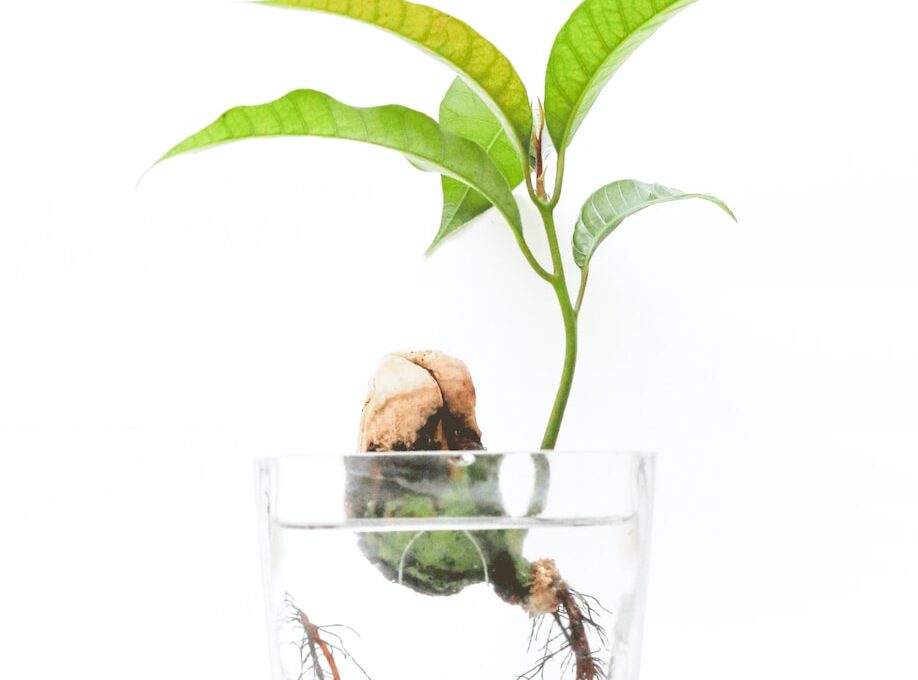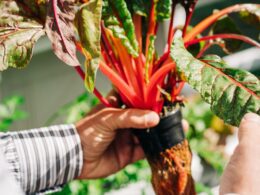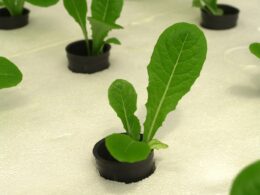Are you trying to make healthier food choices but worried about the safety of your produce?
Hydroponic lettuce may be a solution for you. Hydroponic farming is a method of growing plants without soil, using nutrient-rich water instead. This method of farming has been gaining popularity in recent years due to its efficiency and sustainability.
However, you may be wondering if hydroponic lettuce is actually healthy for you to consume.
In this article, we will explore the nutritional value of hydroponic lettuce and compare it to conventionally grown lettuce. We will also address any potential health risks associated with consuming hydroponic lettuce and discuss the safety regulations and standards in place to ensure its safety.
By the end of this article, you will have a better understanding of whether hydroponic lettuce is a healthy and safe choice for you and your family.
Nutritional Value of Hydroponic Lettuce
Looking to boost your daily nutrient intake? Look no further than the fresh, leafy greens grown using hydroponic farming, a modern soil-free gardening method.
Hydroponic lettuce is packed with essential vitamins and minerals that can help support your overall health and well-being. Unlike traditional farming methods, hydroponic farming allows for precise control over the nutrient composition of the plants. This means that hydroponic lettuce can have higher levels of certain vitamins and minerals, such as vitamin C and potassium, than conventionally grown lettuce.
Additionally, hydroponic farming uses less water and no pesticides, making it an eco-friendly and sustainable option. While hydroponic farming is not currently eligible for organic certification due to the lack of soil, it is still a healthy and nutritious option for those looking to add more greens to their diet.
So why not try swapping out your conventional lettuce for hydroponic lettuce and reap the benefits of this innovative and sustainable farming method?
Comparison to Conventionally Grown Lettuce
You may be surprised to learn that the lettuce you’re used to seeing at the grocery store may not be as fresh as you think. Conventionally grown lettuce can take weeks to reach the store shelves, and during that time, it loses some of its nutritional value.
On the other hand, hydroponic lettuce is grown in water, and it can be harvested and delivered to stores in a matter of days. This means that hydroponic lettuce retains more of its nutrients than conventionally grown lettuce.
When it comes to cost comparison, hydroponic lettuce may be slightly more expensive than conventionally grown lettuce. However, the benefits of hydroponic lettuce are worth the extra cost. As mentioned earlier, hydroponic lettuce retains more of its nutrients, which means you’ll be getting more bang for your buck. Additionally, hydroponic lettuce is grown without pesticides, which is better for your health in the long run.
Lastly, taste preference is subjective, but many people find that hydroponic lettuce tastes better than conventionally grown lettuce. This could be because hydroponic lettuce is grown in a perfectly controlled environment, which allows it to develop a more consistent flavor.
So, if you’re looking for a healthier and tastier option, consider trying hydroponic lettuce. It may be slightly more expensive, but the benefits are well worth it.
Potential Health Risks
Growing plants without soil can pose some risks to our well-being. While hydroponic lettuce is generally considered safe, there are still potential health risks that you should be aware of. Here are some things to keep in mind:
-
Pesticide residues: Hydroponic lettuce is often grown in greenhouses, which means that farmers may use pesticides to control pests and diseases. While these pesticides are generally considered safe, they can leave residues on the lettuce that may be harmful to your health if consumed in large quantities.
-
Microbial contamination: Hydroponic lettuce can also be at risk of microbial contamination. This can happen if the water used in the hydroponic system is not properly sanitized or if the lettuce is not harvested and stored correctly. Eating contaminated lettuce can lead to food poisoning and other health problems.
-
The benefits of hydroponic lettuce: It’s worth noting that hydroponic lettuce has many benefits, including being free of soil-borne diseases and parasites. Additionally, because hydroponic systems use less water than traditional farming methods, hydroponic lettuce is often considered more environmentally friendly.
To minimize the potential health risks of hydroponic lettuce, it’s important to take the following precautions:
-
Wash your hands before handling hydroponic lettuce, and wash the lettuce thoroughly before consuming it.
-
Buy hydroponic lettuce from a reputable source that follows proper food safety protocols.
-
Store hydroponic lettuce in the refrigerator at 40 degrees Fahrenheit or below.
-
Use hydroponic lettuce within a few days of purchase to minimize the risk of contamination.
By following these guidelines, you can enjoy the many benefits of hydroponic lettuce while minimizing potential health risks.
Is Hydroponic Lettuce Safe for Consumption?
Hydroponic lettuce safety is a concern for many consumers. However, studies have shown that hydroponically grown lettuce is safe for consumption. Since it is grown in a controlled environment without soil, the risk of soil-borne pathogens is significantly reduced. Furthermore, strict regulations and quality control measures ensure that hydroponic lettuce meets safety standards.
Safety Regulations and Standards
Make sure you’re aware of the safety regulations and standards in place to protect you and your loved ones when enjoying hydroponic lettuce. Hydroponic farming techniques have gained popularity due to its innovative and sustainable method of growing produce. With any food product, it is important to understand the safety measures put in place by the government to ensure that it is safe for consumption.
The government oversees the production of hydroponic lettuce to ensure that it meets safety standards. Hydroponic farms are required to follow strict guidelines in order to sell their produce to the public. These guidelines include testing for harmful bacteria and chemicals, as well as following proper sanitation practices. Additionally, hydroponic farms are subject to regular inspections to ensure that they continue to follow these guidelines.
It is important to note that the safety of hydroponic lettuce is just as important as conventionally grown lettuce. Government oversight ensures that hydroponic farms meet the same safety standards as traditional farming methods. By following these regulations and standards, hydroponic lettuce can be a safe and healthy option for you and your family.
Conclusion and Recommendations
In conclusion, it’s important to know that there are safety regulations and standards in place for hydroponic lettuce. These regulations cover water quality, nutrient content, and pest control, ensuring that the produce you’re eating is safe and healthy. By adhering to these regulations, hydroponic lettuce is just as safe to eat as conventionally grown lettuce.
Not only is hydroponic lettuce safe to eat, but it also has implications for sustainability and cost savings. Hydroponic systems are more efficient and have a lower environmental impact, using less water and space than traditional farming methods. Hydroponic lettuce can also be grown year-round, which means it can be produced locally and doesn’t have to be shipped long distances, reducing transportation costs and carbon emissions.
Overall, hydroponic lettuce is a safe and healthy option for those looking to incorporate more fresh produce into their diet. Supporting sustainable and efficient farming methods can improve our own health and the health of the planet. So next time you’re at the grocery store, consider choosing hydroponic lettuce for a delicious and environmentally conscious choice.
Frequently Asked Questions
What are the different types of hydroponic systems used to grow lettuce?
If you’re curious about the different types of hydroponic systems used to grow lettuce, you’ll find that vertical farming is a great option.
This method involves stacking layers of plants on top of each other, which maximizes space and efficiency.
To keep the plants healthy, nutrient solutions are used to provide the necessary minerals and vitamins. These solutions are carefully crafted to meet the specific needs of the lettuce plants, ensuring that they grow strong and healthy.
With this type of system, you can enjoy fresh, flavorful lettuce all year round, without worrying about pesticides or other harmful chemicals.
How does the taste of hydroponic lettuce compare to conventionally grown lettuce?
When it comes to taste, hydroponic lettuce can differ from conventionally grown lettuce. Some people find that hydroponic lettuce has a milder, more delicate flavor compared to its traditional counterpart. However, this taste difference can be subjective and may not be noticeable to everyone.
In terms of nutritional value, hydroponic lettuce can be just as healthy as conventionally grown lettuce, as long as it is grown using a nutrient-rich solution. So, if you’re looking for a tasty and nutritious option, hydroponic lettuce may be worth trying.
Can hydroponic lettuce be grown without the use of pesticides or other chemicals?
Looking to grow hydroponic lettuce without the use of pesticides or other chemicals? It’s definitely possible!
To achieve the organic certification, hydroponic growers need to adhere to strict guidelines that ensure their produce is free from harmful chemicals. Additionally, hydroponic systems allow for precise control over nutrient absorption, meaning that growers can create a nutrient-rich environment for their plants without the need for synthetic fertilizers.
With these practices in place, hydroponic lettuce can be just as healthy and safe to eat as conventionally grown lettuce.
What is the environmental impact of hydroponic lettuce production compared to traditional farming methods?
When it comes to environmental sustainability and resource efficiency, hydroponic lettuce production has some clear advantages over traditional farming methods.
For one, hydroponic systems use significantly less water and land than traditional farming, which means less strain on local resources and a reduced carbon footprint.
Additionally, hydroponic systems can be set up in urban areas, shortening the distance between production and consumption and further reducing emissions.
While there are certainly some challenges associated with hydroponic lettuce production, such as the energy required to power the systems and the potential for nutrient runoff, overall it’s a promising option for those looking to reduce their environmental impact while still enjoying fresh, locally grown produce.
Are there any notable differences in the texture or appearance of hydroponic lettuce compared to conventionally grown lettuce?
When it comes to texture differences, hydroponic lettuce tends to be more tender and less bitter than conventionally grown lettuce. This may be because hydroponic lettuce is grown in a controlled environment with precise nutrient levels, resulting in a more consistent and uniform taste.
In terms of nutritional benefits, hydroponic lettuce can actually be more nutrient-dense than conventionally grown lettuce. This is because hydroponic systems allow for faster growth and better absorption of nutrients, resulting in higher levels of vitamins and minerals.
So, if you’re looking for a tasty and nutritious option, hydroponic lettuce may be the way to go!
Conclusion
So, is hydroponic lettuce healthy? Yes, it can be a nutritious and safe option for consuming lettuce. Hydroponic lettuce has been found to have similar or even higher levels of vitamins and minerals compared to conventionally grown lettuce.
However, it’s important to note that hydroponic lettuce may have a higher risk of bacterial contamination due to the controlled environment and potential for stagnant water. It’s crucial to follow safety regulations and standards when growing and consuming hydroponic lettuce to minimize any potential health risks.
Overall, hydroponic lettuce can be a healthy addition to your diet as long as proper precautions are taken.







